The dry chain: Reducing postharvest losses and improving food safety in humid climates
a Department of Plant Sciences, Seed Biotechnology Center, University of California, Davis, CA, USA; b Rhino Research, Moo Baan Sai Samphan 66/17, Phichit, Thailand; c Department of Seed Science & Technology, Professor Jayashankar Telangana State Agriculture University, Rajendra Nagar, Hyderabad, India; d Department of Biological and Agricultural Engineering, University of California, Davis, CA, USA.
Background: Even as increasing populations put pressure on food supplies, about one-third of the total food produced for human consumption is wasted, with the majority of loss in developing countries occurring between harvest and the consumer. Controlling product dryness is the most critical factor for maintaining quality in stored non-perishable foods. The high relative humidity prevalent in humid climates elevates the moisture content of dried commodities stored in porous woven bags, enabling fungal and insect infestations. Mycotoxins (e.g., aflatoxin) produced by fungi in insufficiently dried food commodities affect 4.5 billion people worldwide. Scope and approach: We introduce the term “dry chain” to describe initial dehydration of durable commodities to levels preventing fungal growth followed by storage in moisture-proof containers. This is analogous to the “cold chain” in which continuous refrigeration is used to preserve quality in the fresh produce industry. However, in the case of the dry chain, no further equipment or energy input is required to maintain product quality after initial drying as long as the integrity of the storage container is preserved. In some locations/seasons, only packaging is required to implement a “climate smart” dry chain, while in humid conditions, additional drying is required and desiccant-based drying methods have unique advantages. Key findings and conclusions: We propose both climate-based and drying-based approaches to implement the dry chain to minimize mycotoxin accumulation and insect infestations in dry products, reduce food loss, improve food quality, safety and security, and protect public health.
Keywords: Dry chain Aflatoxin Drying Food waste Postharvest storage
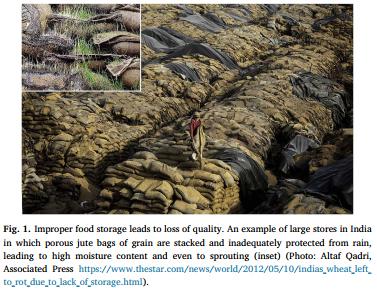

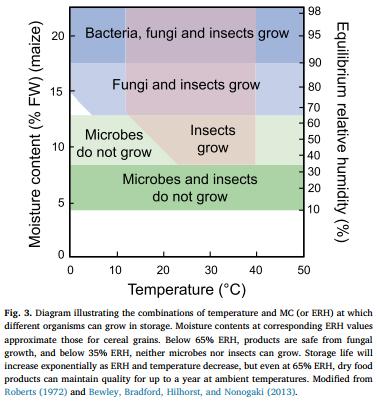
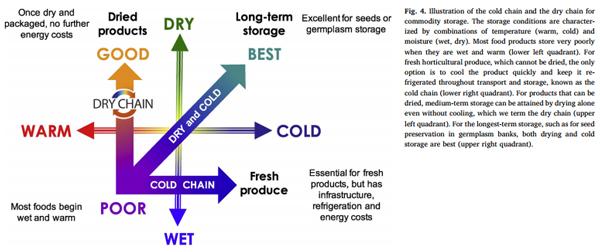
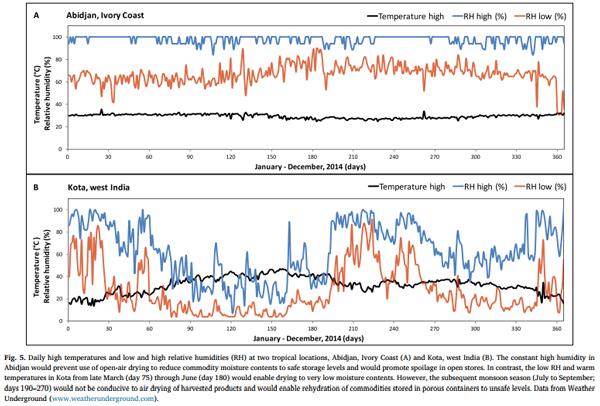
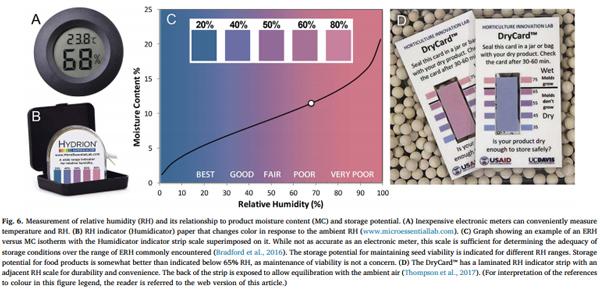
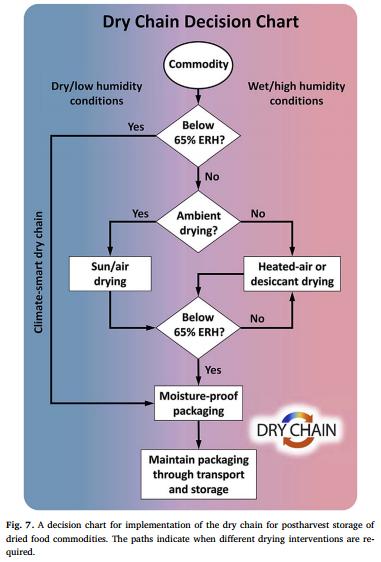
Abalone, R., Gastón, A., Bartosik, R., Cardoso, L., & Rodríguez, J. (2011). Gas concentration in the interstitial atmosphere of a wheat silo-bag. Part I: Model development and validation. Journal of Stored Products Research, 47(4), 268–275. http://dx. doi.org/10.1016/j.jspr.2011.05.004.
Abdel-Hadi, A., Schmidt-Heydt, M., Parra, R., Geisen, R., & Magan, N. (2011). A systems approach to model the relationship between aflatoxin gene cluster expression, environmental factors, growth and toxin production by Aspergillus flavus. Journal of the Royal Society Interface, 1–11. http://dx.doi.org/10.1098/rsif.2011.0482.
Afzal, I., Bakhtavar, M. A., Ishfaq, M., Sagheer, M., & Baributsa, D. (2017). Maintaining dryness during storage contributes to higher maize seed quality. Journal of Stored Products Research, 72, 49–53.http://dx.doi.org/10.1016/j.jspr.2017.04.001.
Alberts, J. F., Lilly, M., Rheeder, J. P., Burger, H. M., Shephard, G. S., & Gelderblom, W. C. A. (2017). Technological and community-based methods to reduce mycotoxin exposure. Food Control, 73, 101–109. http://dx.doi.org/10.1016/j.foodcont.2016.05. 029.
Alexandratos, N., & Bruinsma, J. (2012). World agriculture towards 2030/2050: The 2012 revision. Rome, FAO: ESA Working paper No. 12–03.
Ann, C. T. (1996). Lack of incentives as constraints to introduction of efficient drying systems. In B. R. Champ, E. Highley, & G. I. Johnson (Eds.). Grain drying in Asia (pp. 74–79). Canberra, Australia: Australian Centre for International Agricultural Research.
Baoua, I. B., Amadou, L., Ousmane, B., Baributsa, D., & Murdock, L. L. (2014). PICS bags for post-harvest storage of maize grain in West Africa. Journal of Stored Products Research, 58, 20–28. http://dx.doi.org/10.1016/j.jspr.2014.03.001.
Baributsa, D., Djibo, K., Lowenberg-DeBoer, J., Moussa, B., & Baoua, I. (2014). The fate of triple-layer plastic bags used for cowpea storage. Journal of Stored Products Research, 58, 97–102. http://dx.doi.org/10.1016/j.jspr.2014.02.011.
Bello, P., & Bradford, K. J. (2016). Single-seed oxygen consumption measurements and population-based threshold models link respiration and germination rates under diverse conditions. Seed Science Research, 26(3), 199–221. http://dx.doi.org/10.1017/ S0960258516000179
Bewley, J. D., Bradford, K. J., Hilhorst, H. W. M., & Nonogaki, H. (2013). Seeds: Physiology of development, germination and dormancy (3rd ed.). New York: Springer.
Bradford, K. J., Dahal, P., & Bello, P. (2016). Using relative humidity indicator paper to measure seed and commodity moisture contents. Agricultural & Environmental Letters, 1, 160018. http://dx.doi.org/10.2134/ael2016.04.0018.
Bradford, K. J., Dahal, P., Day, R., Phiri, N. A., Musebe, R., Karanja, D., ... Van Asbrouck, J. (2014). Improving seed quality for smallholders. Retrieved 21 July, 2017, from www. dryingbeads.org.
Burney, J. A., Davis, S. J., & Lobell, D. B. (2010). Greenhouse gas mitigation by agricultural intensification. Proceedings of the National Academy of Sciences USA, 107(26), 12052–12057. http://dx.doi.org/10.1073/pnas.0914216107.
Champ, B. R., Highley, E., & Johnson, G. I. (Eds.). (1996). Grain drying in Asia. Canberra, Australia: Australian Centre for International Agricultural Research. Chen, C. (2000). Factors which effect equilibrium relative humidity of agricultural products. Transactions of the American Society of Agricultural Engineers, 43(3), 673–683.
Chen, C. (2001). Moisture measurement of grain using humidity sensors. Transactions of the American Society of Agricultural Engineers, 44(5), 1241–1245.
Chen, J.-G., Egner, P. A., Ng, D., Jacobson, L. P., Muñoz, A., Zhu, Y.-R., ... Kensler, T. W. (2013). Reduced aflatoxin exposure presages decline in liver cancer mortality in an endemic region of China. Cancer Prevention Research, 6(10), 1038–1045. http://dx. doi.org/10.1158/1940-6207.capr-13-0168.
Chomchalow, N. (2003). Protection of stored products with special reference to Thailand. Assumption University Journal of Technology, 7(1), 31–47.
Chua, K. J., & Chou, S. K. (2003). Low-cost drying methods for developing countries. Trends in Food Science and Technology, 14, 519–528. http://dx.doi.org/10.1016/j.tifs. 2003.07.003.
Chulze, S. N. (2010). Strategies to reduce mycotoxin levels in maize during storage: A review. Food Additives & Contaminants: Part A, 27(5), 651–657. http://dx.doi.org/10. 1080/19440040903573032.
Crowe, J. H., Hoekstra, F. A., & Crowe, L. M. (1992). Anhydrobiosis. Annual Review of Physiology, 54(1), 579–599. http://dx.doi.org/10.1146/annurev.ph.54.030192. 003051.
Dadlani, M., Mathur, P., & Gupta, A. (2016). Community seed banks. Agriculture World, 2(1), 6–9. https://issuu.com/krishijagran/docs/krishi_jagran_agriculture_world-jan. Darwish, W. S., Ikenaka, Y., Nakayama, S. M. M., & Ishizuka, M. (2014). An overview on mycotoxin contamination of foods in Africa. The Journal of Veterinary Medical Science, 76(6), 789–797. http://dx.doi.org/10.1292/jvms.13-0563.
De Bruin, T., Villers, P., Wagh, A., & Narvarro, S. (2012). Worldwide use of hermetic storage for the preservation of agricultural products. Paper presented at the 9th international controlled atmosphere & fumigation conference (Antalya, Turkey).
De Padua, D. (1996). Perspectives on drying problems in the Southeast Asian region and results of R&D projects to solve them. In B. R. Champ, E. Highley, & G. I. Johnson (Eds.). Grain drying in Asia (pp. 67–73). Canberra, Australia: Australian Centre for International Agricultural Research.
Dou, Z., Ferguson, J. D., Galligan, D. T., Kelly, A. M., Finn, S. M., & Giegengack, R. (Eds.). (2016). Food waste across the supply chain. A U.S. Perspective on a global problem. Ames, Iowa: Council for Agricultural Science and Technology.
Ellis, R. H. (1988). The viability equation, seed viability nomographs, and practical advice on seed storage. Seed Science & Technology, 16(1), 29–50.
Ellis, R. H., & Hong, T. D. (2007). Seed longevity - moisture content relationships in hermetic and open storage. Seed Science and Technology, 35(2), 423–431.
FAO (1989a). Prevention of post-harvest food losses fruits, vegetables and root crops: A training manual. FAO Training Series: no. 17/2Rome, Italy: Food and Agriculture Organization of the United Nations. http://www.fao.org/docrep/t0073e/t0073e00. HTM.
FAO (1989b). Problem of pesticide residue in stored grain. Rome, Italy: Group for assistance on systems relating to grain after harvest, Executive Meeting, Amsterdam http:// www.fao.org/wairdocs/x5003e/X5003e00.htm#Contents.
FAO (2014). Code of practice for the prevention and reduction of mycotoxin contamination in cereals. CAC/RCP 51–2003: Codex AlimentariusFood and Agriculture Organization of the United Nationswww.fao.org/fao-who-codexalimentarius/standards/en/.
FAO (1994). Grain storage techniques - evolution and trends in developing countries (vol. FAO agricultural services bulletin No. 109). Rome, Italy: Food and Agriculture Organization of the United Nations. www.fao.org/docrep/t1838e/T1838E00.HTM.
Fontana, A. (2007). Minimum water activity limits for growth of microorganisms. In G. V. Barbosa-Cánovas, A. J. Fontana, S. J. Schmidt, & T. P. Labuza (Eds.). Water activity in foods. Fundamentals and Applications (pp. 405–406). Ames, Iowa: Blackwell Publishing Ltd.
García, S., & Heredia, N. L. (2014). Aflatoxins: An overview. In J. B. Dixon, A. L. Barrientos Velázquez, & Y. Deng (Eds.). Aflatoxin Control: Safeguarding animal feed with calcium smectite. Madison, WI: American Society of Agronomy and Soil Science Society of America.
Godfray, H. C. J., Beddington, J. R., Crute, I. R., Haddad, L., Lawrence, D., Muir, J. F., ... Toulmin, C. (2010). Food security: The challenge of feeding 9 billion people. Science, 327(5967), 812–818. http://dx.doi.org/10.1126/science.1185383.
Grabe, D. F. (1989). Measurement of seed moisture. In P. C. Stanwood, & M. B. McDonald (Eds.). CSSA special publication No. 14. Seed moisture (pp. 69–92). Madison, WI: Crop Science Society of America.
Gustavsson, J., Cederberg, C., Sonesson, U., Van Otterdijk, R., & Meybeck, A. (2011). Global food losses and food waste. Rome, Italy: Food and Agriculture Organization of the United Nations.
Harrington, J. F. (1972). Seed storage and longevity. In T. T. Kozlowski (Ed.). Seed biology. Volume III. Insects, and seed collection, storage, testing, and certification (pp. 145–245). New York: Academic Press.
Hayma, J. (2003). The storage of tropical agricultural products. Wageningen Agromisa Foundation. Hay, F. R., Thavong, P., Taridno, P., & Timple, S. (2012). Evaluation of zeolite seed ‘Drying Beads® for drying rice seeds to low moisture content prior to long-term storage. Seed Science & Technology, 40, 374–395.
Hay, F. R., & Timple, S. (2013). Optimum ratios of zeolite seed Drying Beads® to dry rice seeds for genebank storage. Seed Science & Technology, 41, 407–419.
Hong, T. D., Ellis, R. H., Astley, D., Pinnegar, A. E., Groot, S. P. C., & Kraak, H. L. (2005). Survival and vigour of ultra-dry seeds after ten years of hermetic storage. Seed Science and Technology, 33(2), 449–460.
Horticulture Innovation Lab (2017). Solar drying adds value to crop surplus. USAID feed the future innovation Lab for collabortive research on horticulture. https://horticulture. ucdavis.edu/main/media%20page/technologies_chimney_solar_dryer.pdf.
IARC (2012). Chemical agents and related occupations, IARC monograph evaluating carcinogen risks to humans. International Agency for Research on Cancer.
IIVR (2016). First low-energy seed gene bank inaugurated at ICAR-IIVR. Varanasi. Varanasi, Uttar Pradesh, India: Indian Institute of Vegetable Research-Indian Council of Agricultural Research. www.iivr.org.in/first-low-energy-seed-gene-bankinaugurated-icar-iivr-varanasi.html.
Ileleji, K. (2016). Purdue-affiliated startup developing solar-powered crop drying device to prevent post-harvest losses for smallholders, small-medium agro-processors. https://www. purdue.edu/newsroom/releases/2016/Q4/purdue-affiliated-startup-developingsolar-powered-crop-drying-device-to-prevent-post-harvest-losses-for-smallholders,- small-medium-agro-processors.html, Accessed date: 31 October 2017.
Iqbal, J., & Ahmad, M. (2014). Comparative performance of selected ear-corn drying techniques. ARPN Journal of Engineering and Applied Sciences, 9(4), 574–579.
IRRI (2016). Rice knowledge bank. Cocoon. from www.knowledgebank.irri.org/step-bystep-production/postharvest/storage/cocoon. ISTA (2004). International rules for seed testing (2004 ed.). Bassersdorf, Switzerland: ISTA.
Kabak, B., Dobson, A. D. W., & Var, I. (2006). Strategies to prevent mycotoxin contamination of food and animal feed: A review. Critical Reviews in Food Science and Nutrition, 46(8), 593–619. http://dx.doi.org/10.1080/10408390500436185.
Kader, A. A. (Ed.). (2002). Postharvest technology of horticultural crops(3rd ed.). Oakland, California: University of California Agriculture and Natural Resources.
Kensler, T. W., Roebuck, B. D., Wogan, G. N., & Groopman, J. D. (2011). Aflatoxin: A 50- year odyssey of mechanistic and translational toxicology. Toxicological Sciences, 120(Suppl 1), S28–S48.
Khlangwiset, P., Shephard, G. S., & Wu, F. (2011). Aflatoxins and growth impairment: A review. Critical Reviews in Toxicology, 41(9), 740–755. http://dx.doi.org/10.3109/ 10408444.2011.575766.
Kuiper-Goodman, T. (1998). Food safety: Mycotoxins and phycotoxins in perspective. In M. Miraglia, H. van Edmond, C. Brera, & J. Gilbert (Eds.). Mycotoxins and phycotoxinsdevelopments in chemistry, toxicology and food safety (pp. 25–48). Fort Collins, CO: Alaken.
Kumar, D., & Kalita, P. (2017). Reducing postharvest losses during storage of grain crops to strengthen food security in developing countries. Foods, 6(1), 8. http://dx.doi.org/ 10.3390/foods6010008.
Kunusoth, K., Dahal, P., Van Asbrouck, J. V., & Bradford, K. J. (2012). New technology for postharvest drying and storage of seeds. Seed Times (New Delhi), 5, 33–38. https:// nsai.co.in/publication-magazine.
Lacey, J., Hamer, A., & Magan, N. (1994). Respiration and losses in stored wheat under different environmental conditions. Paper presented at the stored product protection, proceedings of the 6th international working conference on stored-product protection (Canberra, Australia).
Lantin, R. M., Paita, B. L., & Manaligod, H. T. (1996). Revisiting sun drying of grain: Widely adopted but technologically neglected. In B. R. Champ, E. HIghley, & G. I. Johnson (Eds.). Grain drying in Asia (pp. 302–307). Canberra, Australia: Australian Centre for International Agricultural Research.
Lee, J., Gereffi, G., & Beauvais, J. (2012). Global value chains and agrifood standards: Challenges and possibilities for smallholders in developing countries. Proceedings of the National Academy of Sciences, 109(31), 12326–12331. http://dx.doi.org/10.1073/ pnas.0913714108.
Lipinski, B., Hanson, C., Lomax, J., Kitinoja, L., Waite, R., & Searchinger, T. (2013). Reducing food loss and Waste: Working paper, installment 2 of creating a sustainable food future. Washington, DC: World Resources Institute. http://www. worldresourcesreport.org.
Liu, Y., & Wu, F. (2010). Global burden of aflatoxin-induced hepatocellular carcinoma: A risk assessment. Environmental Health Perspectives, 118(6), 818–824. http://dx.doi. org/10.1289/ehp.0901388.
Lobell, D. B., Cassman, K. G., & Field, C. B. (2009). Crop yield gaps: Their importance, magnitudes, and causes. Annual Review of Environment and Resources, 34, 179–204. http://dx.doi.org/10.1146/annurev.environ.041008.093740.
Magan, N., & Aldred, D. (2007). Post-harvest control strategies: Minimizing mycotoxins in the food chain. International Journal of Food Microbiology, 119, 131–139. http://dx. doi.org/10.1016/j.ijfoodmicro.2007.07.034.
Memedovic, O., & Shepherd, A. (2009). Agri-food value chains and poverty reduction: Overview of main issues, trends and experiences. Vienna: United Nations Industrial Development Organization.
Mendoza, J. R., Kok, C. R., Stratton, J., Bianchini, A., & Hallen-Adams, H. E. (2017a). Understanding the mycobiota of maize from the highlands of Guatemala, and implications for maize quality and safety. Crop Protection, 101, 5–11. http://dx.doi.org/ 10.1016/j.cropro.2017.07.009.
Mendoza, J. R., Sabillón, L., Martinez, W., Campabadal, C., Hallen-Adams, H. E., & Bianchini, A. (2017b). Traditional maize post-harvest management practices amongst smallholder farmers in Guatemala. Journal of Stored Products Research, 71, 14–21. http://dx.doi.org/10.1016/j.jspr.2016.12.007.
Mrema, G. C. (2011). Grain crop drying, handling and storage rural structures in the Tropics: Design and development. Rome: FAO. Murdock, L. L., & Baoua, I. B. (2014). On Purdue Improved Cowpea Storage (PICS) technology: Background, mode of action, future prospects. Journal of Stored Products Research, 58(0), 3–11. http://dx.doi.org/10.1016/j.jspr.2014.02.006.
Murdock, L. L., Margam, V., Baoua, I., Balfe, S., & Shade, R. E. (2012). Death by desiccation: Effects of hermetic storage on cowpea bruchids. Journal of Stored Products Research, 49, 166–170. http://dx.doi.org/10.1016/j.jspr.2012.01.002.
Mutters, R. G., & Thompson, J. F. (2009). Rice quality handbook. Publication 3514Oakland, CA: University of California Agriculture and Natural Resources. Nagpal, M., & Kumar, A. (2012). Grain losses in India and government policies. Quality Assurance and Safety of Crops & Foods, 4(3), http://dx.doi.org/10.1111/j.1757-837X. 2012.00150.x 143–143.
NDTV (2013). Rot destroys thousands of quintals of rice meant for poor in Uttar Pradesh. News report June 18, 2013 http://www.ndtv.com/video/player/news/rot-destroysthousands-of-quintals-of-rice-meant-for-poor-in-uttar-pradesh/279743, Accessed date: 21 July 2017.
Ng'ang'a, J., Mutungi, C., Imathiu, S., & Affognon, H. (2016a). Effect of triple-layer hermetic bagging on mould infection and aflatoxin contamination of maize during multimonth on-farm storage in Kenya. Journal of Stored Products Research, 69, 119–128. http://dx.doi.org/10.1016/j.jspr.2016.07.005.
Ng’ang’a, J., Mutungi, C., Imathiu, S. M., & Affognon, H. (2016b). Low permeability triple-layer plastic bags prevent losses of maize caused by insects in rural on-farm stores. Food Security, 1–13. http://dx.doi.org/10.1007/s12571-016-0567-9.
Omobowale, M. O., Armstrong, P. R., Mijinyawa, Y., Igbeka, J. C., & Maghirang, E. B. (2016). Maize storage in termite mound clay, concrete, and steel silos in the humid tropics: Comparison and effect on bacterial and fungal counts. Transactions of the American Society of Agricultural and Biological Engineers, 59(3), 1039–1048. http://dx. doi.org/10.13031/trans.59.11437.
PACA (2016). Partnership for aflatoxin control in Africa. Retrieved 21 July, 2017, from www.aflatoxinpartnership.org. Parfitt, J., Barthel, M., & Macnaughton, S. (2010). Food waste within food supply chains: Quantification and potential for change to 2050. Philosophical Transactions of the Royal Society of London. Series B: Biological Sciences, 365(1554), 3065–3081. http:// dx.doi.org/10.1098/rstb.2010.0126.
Pérez-García, F., González-Benito, M. E., & Gómez-Campo, C. (2007). High viability recorded in ultra-dry seeds of 37 species of Brassicaceae after almost 40 years of storage. Seed Science & Technology, 35, 143–153.
PICS (2015). PICS network. Retrieved 21 July, 2017, from https://picsnetwork.org/.
Roberts, E. H. (1972). Storage environment and the control of viability. In E. H. Roberts (Ed.). Viabilty of seeds (pp. 14–58). Syracuse, NY: Chapman and Hall Ltd. Roberts, E. H., & Ellis, R. H. (1989). Water and seed survival. Annals of Botany, 63(1), 39–52.
Rockefeller Foundation (2013). Waste and spoilage in the food chain. Decision intelligence document. Retrieved 15 April, 2016, from https://www.rockefellerfoundation.org/ app/uploads/Waste-and-Spoilage-in-the-Food-Chain.pdf.
Rockefeller Foundation (2017). YieldWise. Reducing post-harvest food loss for African farmers. Retrieved 21 July, 2017, from https://www.rockefellerfoundation.org/ourwork/initiatives/yieldwise/.
Salvatierra-Rojas, A., Nagle, M., Gummert, M., de Bruin, T., & Muller, J. (2017). Development of an inflatable solar dryer for improved postharvest handling of paddy rice in humid climates. International Journal of Agricultural and Biological Engineering, 10(3), 269–282. http://dx.doi.org/10.3965/j.ijabe.20171003.2444.
Schmidt, C. W. (2013). Breaking the mold: New strategies for fighting aflatoxin. Environmental Health Perspectives, 121(9), A271–A275. http://dx.doi.org/10.1289/ ehp.121-a270.
Standards, A. S. A. E. (1991). D245.4: Moisture relationships of grains (38th ed.). St. Joseph, MI: American Society of Agricultural Engineers.
Taruvinga, C., Mejia, D., & Alvarez, J. S. (2014). Appropriate seed and grain storage systems for small-scale farmers: Key practices for DRR implementers. Retrieved 21 July, 2017 from http://www.fao.org/3/a-i3769e.pdf.
Temba, B. A., Sultanbawa, Y., Kriticos, D. J., Fox, G. P., Harvey, J. J. W., & Fletcher, M. T. (2016). Tools for defusing a major global food and feed safety risk: Nonbiological postharvest procedures to decontaminate mycotoxins in foods and feeds. Journal of Agricultural and Food Chemistry, 64(47), 8959–8972. http://dx.doi.org/10.1021/acs. jafc.6b03777.
Thompson, J. F., Reid, M. S., Felix, L., Donis-Gonzalez, I., Mjawa, B., & Ambuko, J. (2017). Dry Card™ – a low-cost dryness indicator for dried products. AIMS Agriculture and Food, 2(4), 339–344. http://dx.doi.org/10.3934/agrfood.2017.4.339.
Timsina, K. P., Bradford, K. J., Dahal, P., Shivakoti, G. P., Kunusoth, K., Van Asbrouck, J., ... Pandey, I. R. (2018). Potential impacts of desiccant-based drying and hermetic storage on the value chain for onion seeds in Nepal. Journal of Agribusiness in Developing and Emerging Economies (in press).
Tubbs, T., Woloshuk, C., & Ileleji, K. (2017). A simple low-cost method of determining whether it is safe to store maize. AIMS Agriculture and Food, 2(1), 43–55. http://dx. doi.org/10.3934/agrfood.2017.1.43.
Turner, P. C., Sylla, A., Gong, Y. Y., Diallo, M. S., Sutcliffe, A. E., Hall, A. J., et al. (2005). Reduction in exposure to carcinogenic aflatoxins by postharvest intervention measures in west Africa: A community-based intervention study. The Lancet, 365(9475), 1950–1956. http://dx.doi.org/10.1016/S0140-6736(05)66661-5.
United Nations (2015). World population Prospects: The 2015 revision, key findings and advance tables. Working Paper No. ESA/P/WP.241 . Retrieved 21 July, 2017, from http://esa.un.org/unpd/wpp/publications/files/key_findings_wpp_2015.pdf.
Unnevehr, L., & Grace, D. (2013). Aflatoxins: Finding solutions for improved food safety. International Food Policy Research Institute. Retrieved 21 July, 2017, from https:// www.ifpri.org/publication/aflatoxins-finding-solutions-improved-food-safety.
USDA (2006). Grain fungal diseases and mycotoxins reference. Retrieved 21 July, 2017, from www.gipsa.usda.gov/fgis/publication/ref/mycobook.pdf.
Van Asbrouck, J., & Kunusoth, K. (2015). Scaling and commercialization of drying technologies for improved horticultural seed and processing quality. Retrieved 21 July, 2017, from http://horticulture.ucdavis.edu/main/projects/scaling_drying_beads.html.
Van Asbrouck, J., & Taridno, P. (2009). Fast field drying as a method to maintain quality, increase shelf life and prevent post harvest infections of Cucumis sativum L. Asian Journal of Food and Agricultural Industry, Special Issue, S133–S137.
Walters, C., Farrant, J. M., Pammenter, N. W., & Berjak, P. (2002). Desiccation stress and damage. In M. Black, & H. W. Pritchard (Eds.). Desiccation and survival in plants. Drying without dying (pp. 263–291).
Wallingford, Oxon, UK: CABI Publishing. White, N. D. G., Sinha, R. N., & Muir, W. E. (1982). Intergranular carbon dioxide as an indicator of biological activity associated with the spoilage of stored wheat. Canadian Agricultural Engineering, 24, 35–42.
Wild, C. P., Miller, J. D., & Groopman, J. D. (Eds.). (2015). Mycotoxin control in low- and middle-income countriesLyon, France: International Agency for Research on Cancer. IARC Working Group Report No. 9. Retrieved 21 July, 2017 from http://publications. iarc.fr/Book-And-Report-Series/Iarc-Working-Group-Reports/Mycotoxin-Control-InLow-And-Middle-Income-Countries-2015.
Williams, S. B., Baributsa, D., & Woloshuk, C. (2014). Assessing Purdue Improved Crop Storage (PICS) bags to mitigate fungal growth and aflatoxin contamination. Journal of Stored Products Research, 59, 190–196. http://dx.doi.org/10.1016/j.jspr.2014.08. 003.
Williams, S. B., Murdock, L. L., & Baributsa, D. (2017). Storage of maize in Purdue improved crop storage (PICS) bags. Plos One, 12(1), 12. http://dx.doi.org/10.1371/ journal.pone.0168624.
Williams, J. H., Phillips, T. D., Jolly, P. E., Stiles, J. K., Jolly, C. M., & Aggarwal, D. (2004). Human aflatoxicosis in developing countries: A review of toxicology, exposure, potential health consequences, and interventions. American Journal Clinical Nutrition, 80, 1106–1122.
World Bank (2011). Missing food: The case of postharvest grain losses in sub-Saharan Africa. Report Number 60371-AFRWashington, DC: The World Bank. Retrieved 21 July, 2017, from http://www.fao.org/3/a-at454e.pdf.
There is no disagreement that a system approach is needed. However, FAO points to postharvest food management critical to food security. Sadly, dry food grains are damaged annually by flloding in south Asia and elsewhere. Drying food/feed rapidly to "suitability to milling or processing moisture content" and packaging into pesticide-free moisture-proof containers would additionally minimize nutrient losses and molds and insect infestations. Monitoring for mycotoxins and other pesticides would complement nutrition security efforts.
In my opinion, we have to look at the entire process. If we do the due diligence of checking the grain from the arrival at the plant, checking moisture levels, broken kernels, protein, etc, we can start avoiding a lot of the problems. Again I reiterate that following a HASAP process could help eliminate many problems.
I have observed in the field that many checks in foreign countries are done by the guards at the entrance to the farm and weights. They are not familiar with the 8 points of testing the truck, therefore a lot gets missed. In many countries also determined by using a UV light to see aflatoxin in grains and not other toxins that may be present. Remember all start with the raw material and end up in the feed. Storage conditions also may affect damage by mycotoxins due to insect and rats fecal mater. No matter all ingested mycotoxins will affect the animal organs. Using a good mold absorbent that includes, probiotics, prebiotic, mold inhibitors, clay and cilimarine will help re Genaro the live damaged by mycotoxins. Not only we should lol at the problem, but also look at a good solution. We all know the damaged caused by mycotoxins contamination, therefore we need to find resolutions and implementation.
We clarified that natural drying could be used in dry seasons/regions. Drying to milling or processing moisture content is the key to achieve safe storage conditions. Seeds do need further drying based on desired storage time. Moisture-proof packaging is needed to maintain the moisture content of dry products (food/feed/seed) achieved by either natural or artificial drying. Usually, the rainy season follows the dry season in most bread basket regions.











